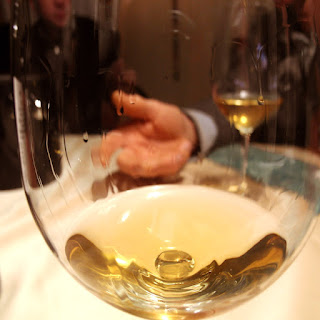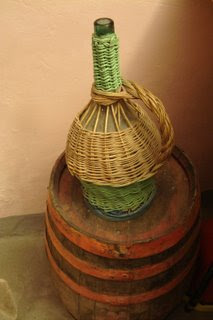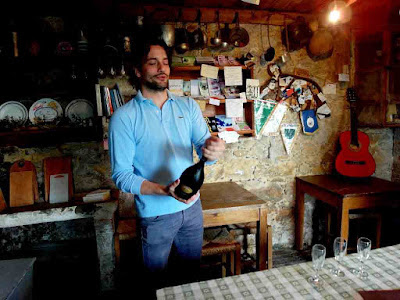Italian wine is a diverse sea of flavors, colors, buoyancies, styles and price points. There are thousands of grapes, and as many or more wines to go along with it. But what drives the business? What grows the market share? And what keeps the lights on?
It falls to four wines, all with relatively humble
beginnings. The four wines encompass four different types of wines – white, red
, sparkling and sweet. And although they may not be on the tip of the tongues of
today’s tony sommeliers, they provide needed cover for the more esoteric and
trendy wines currently being touted by the in-crowd and influencer-wannabes.Too often we chase the trends and forget what brought us here.
Caution advisory: These are not considered cool wines by the high toned up-and-comers. Those dashers consider them boring, dull, run of the mill, yawn, give-me-a-break, get-away-from-me type of wines. They are misinformed.
Let’s start with a dry white: Pinot Grigio. I know, I know, when was the last time anyone had a bottle of that wine? Apparently, a lot of people have, as it still commands a large portion of sales revenue from Italy. So much in fact, that other countries, California notably, have horned in on the action and at this point have surpassed Italy for dominance in the sale of Pinot Grigio in America. Apparently, that thirst is insatiable, as the two, even going at it, neck to neck, are showing growth and success. But let’s talk about the wine – Pinot Grigio.
What made it so initially attractive was a couple of things. It wasn’t overbearing and buttery like so many Chardonnay wines flooding the market. It had a lithe spirit, some fresh fruit, a tingle of acidity and a cleansing palate feel. And it went well with food. Oh, and it was lower in alcohol than Chardonnay (generally) so another glass would be forthcoming after the first glass. Which made it a darling in the restaurant by-the-glass programs, as proprietors could sell more wine, maybe even at lunch. It was also easy to pronounce. I first noticed Pinot Grigio’s entrance on the stage of the popular world when it was referenced in a Seinfeld episode. After that, it just sailed to the top. But what makes it, even now, so ascendant, is that it is fresh, easygoing and accessible to a wide range of tastes and people. It goes well with a number of foods, from American to Italian, Thai, Indian, you name it. It can dance to many tunes. And it is affordable. Pinot Grigio was the little miracle that kept Italian wine in the minds of people, when it came to wine. Maybe not as much now, with more diverse selections and styles. But even now it maintains a dominant position in sales. Which means, it is helping the Italian wine economy grow. It was really a perfect moment for Italy when Pinot Grigio came along and stole America’s vinous heart.
The second wine in the pillar is Chianti.Where to start?
How about a simple carafe of the house Chianti. If you’re in Tuscany, chances are you can access Chianti this way. In other parts of the world, you’ll have to buy a bottle, from the funky fiasco to a deep-punted bottle. From basic Chianti to the more elaborate expression, be they from the Classico zone or Rufina, or a few other districts, with possible riserva and other extended acknowledgment markers. But let’s not get carried away.
Basic Chianti is best when fresh. There, the deliciousness of Sangiovese shows why this wine captured the heart of diners across the globe, a singular eno-revolution of red wine appeal. Dry, yes. Healthy fruit, yes again. Not too heavy. Flexible with different kinds of food, from pizza to pasta, lasagna to richer red sauced foods, like eggplant parm. All staples of the Italian-American cookbook, which brought America (and possibly the world?) into the Italian food (and wine) camp. But in Tuscany, how about a steak, grilled and thick, juicy and mouthwateringly delicious? Chianti was there too. Sidle up to a table at Sostanza in Florence and order their bistecca Fiorentina with a Chianti, will you? Oh sure, you can go with Brunello or a Super Tuscan, or Vino Nobile. But Chianti is the archetype. Start there and press on.
There are Chianti wines capable of sublime beauty. And
there are the workhorses that keep the trains running. Both have their place. There
are even the “new-gen” versions that are popular with the influencer set. Sure,
why not? In the end, it’s Sangiovese’s show. And we’re the willing audience,
enjoying every bite and slurp, every step of the way.
Number three is Prosecco, the much-maligned sparkling love child of the Veneto. Maligned, you say? Or rather, I say? Well, to an extent, yes. Because of the popularity of Prosecco, there are a lot of bad examples of Prosecco. And they are often the best sellers. But before we throw the baby out with the bath water, let’s dig into why Prosecco made it’s mark as one of the mainstays of Italian wine culture.
Have you ever been to Prosecco-land? An hour from Venice, and a world apart. The area in around the the epicenter of Prosecco-land, Valdobbiadene, is one of the most beautiful places in the wine world. I could live there, easily. And apparently the grapes that make up Prosecco think so too.
What gives Prosecco, in its basic form, such an attractiveness, is that it is delicate and not harsh. Lightly dry, usually, although the zero-dosage contingent is also having their moment. And why not? We, the consumer, win on both accounts.
But back to the essence of Prosecco. It isn’t demanding of the imbiber. It doesn’t get in the way of living, of dining, of the conversation, of lovemaking, of everything. It is a background for our lives. And a beautiful one at that. It’s fresh, it’s delicate, it’s affordable, it’s accessible. One of the few wines that when one goes into other regions in Italy and comes upon a wine list (which is often a basic regional list) you will find Prosecco there as well. Sicily, Rome, Milan, all distances from Valdobbiadene. Prosecco has found a way to arrive everywhere on the Italian peninsula. A conquering wine, but one that never subjugates the place, the event or the people whom it has ever so subtly vanquished with pleasure.
And lastly, the fourth pillar – Moscato D’Asti.
“But I don’t like sweet wines!” How many times have we heard that, on the floor of a retail wine shop or a restaurant? And then the client orders an over-ripe (late-harvest) Chardonnay or a Margarita? Sure, no like sweet. Uh huh.
None of us can change anyone’s behavior or their preconceptions. But for those who have an open mind, Moscato has its place. During a holiday, like Christmas or Easter, the festive seasonal cakes that come out pair so beautifully with this fizzy little sweetheart of a wine. Low in alcohol (and calories, but the key here is moderation – good luck on that). A slight spritziness, a liveliness not unlike Prosecco, albeit in a different guise. Less fizz, more fruit, in its inimitable way.
Look, if you don’t have a sweet tooth, Moscato is a hard sale. But that’s not very many of us. Even so, wine, like so many things in our social-media dominated world, trend towards popularity when they are considered to be “in.” Moscato might not be “in” with the hipsters and the rock-star wannabes. So what? It’s very much in with the Italian culture. So, if the hipsters and the rock-star wannabes choose to selectively appropriate Italian culture and Moscato doesn’t make the cut, who gives a doggone about their preferences? You be the judge. But don’t let popular culture dictate what you should and shouldn’t like. Apparently, there are millions of folks who love Moscato, so much that the rest of the winemaking world has rushed to plant and make Moscato in as many iterations as they can. So, someone likes the stuff.
I love Moscato D’Asti. It’s a perfect product of my Italian culture and I embrace it whole heartedly. End of sermon.Yeah, most of these wines can be found in alternate wine culture as well as the mainstream one. For sure you can find an orange Pinot Grigio. As well, one can easily find a “natural” Chianti. Also, you want a Prosecco that is senza zolfo, col fondo, brut zero and metodo ancestrale for the Burning Man set? No problem. Moscato D’Asti for the crunchy Birkenstock sect? Sure, that’s also come-at-able. No one’s going to be left out, when it comes to Italian wines.
But first, try the basic ones. Get an idea of what the
baseline means, before you head off to Findhorn in search of your personal unicorn
wines.









2 comments:
Alfonso, common sense writing. Thank you.
Thanks, Tony. It just makes sense to start with the basics and work out from there. Walk before you run kind of thing. I'm sure there is someone out there who begs to differ. (Like they say, everyone has one.)
Post a Comment